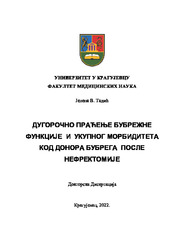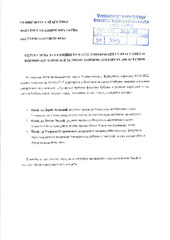Приказ основних података о дисертацији
Дугорочно праћење бубрежне функције и укупног морбидитета код донора бубрега после нефректомије
Long-term monitoring of kidney function and total morbidity with kidney donor after nefrectomy
| dc.contributor.advisor | Petrović, Marijana | |
| dc.contributor.other | Rančić, Nemanja | |
| dc.contributor.other | Petrović, Dejan | |
| dc.contributor.other | Đurić, Dušan | |
| dc.contributor.other | Mijušković, Mirjana | |
| dc.creator | Tadić-Pilčević, Jelena | |
| dc.date.accessioned | 2022-10-17T17:26:05Z | |
| dc.date.available | 2022-10-17T17:26:05Z | |
| dc.date.issued | 2022-06-30 | |
| dc.identifier.uri | http://eteze.kg.ac.rs/application/showtheses?thesesId=8558 | |
| dc.identifier.uri | https://fedorakg.kg.ac.rs/fedora/get/o:1513/bdef:Content/download | |
| dc.identifier.uri | https://nardus.mpn.gov.rs/handle/123456789/20747 | |
| dc.description.abstract | Uvod: Pažljivo praćenje bubrežne funkcije nakon donor nefrektomije je od značaja za program transplantacije bubrega od živog donora. Nefrektomija, inicijalno dovodi do smanjenja funkcije bubrega, koja se prezentuje povećanom proteinurijom i porastom krvnog pritiska. Metod: Studija će biti urađena kao retrospektivna studija tipa slučaj kontrola. Studija će obuhvatiti sve žive donore bubrega kod kojih je urađena donorska nefrektomija od 2004. godine Posmatra će se parametri od interesa pre donor nefrektomije i nakon 6 meseci, 1, 5, 10 i 15 godina. Pacijenti sa donor nefrektomijom sami sebi će biti kontrolna grupa. Prva kontrolna grupa bi bili pacijenti nakon unilateralne nefrektomije zbog karcinoma bubrega, svetloćelijskog karcinoma (stadijum T1bNoM0). Druga kontrolna grupa biće uslovno zdrave osobe sa običnim i/ili parapijeličnim cistama (renalne ciste sa Bosniak klasifikacijom ≤2) slične životne dobi i pola. Očekivani rezultati:Posle donorske nefrektomije, funkcija bubrega je snižena .U prvoj godini se registruje statistički značajan pad ukupne glomerulske filtracije (GFR), dok se u kasnijem posmatranom periodu očekuje delimičan oporavak.Rizik od pojave postransplatacionog dijabetesa, hipertenzije, povišene mokraćne kiseline u krvi je nešto viši u odnosu na opštu populaciju.Rizik od pojave terminalne slabosti bubrega kod donora nije značajno povećan u odnosu na opštu populaciju. Očekivani zaključak: Početno smanjenje GFR nakon donorske nefrektomije nije praćeno daljim ubrzanim gubitkom bubrežne funkcije u odnosu na očekivano smanjenje bubrežne funkcije koje je povezano sa normalnim starenjem. Ova studija bi trebala da pokuša da proceni dugoročni rizik od slabosti bubrega kod donora bubrega i da identifikuje potencijalne davaoce sa najvećim rizikom od dugoročnog morbiditeta. Ključne reči: davaoc bubrega, živa srodna/nesrodna transplatacija bubrega, bubrežna slabost, metaboličke komplikacije, donorska nefrektomija | sr |
| dc.description.abstract | Introduction: Careful renal function monitoring after donor nephrectomy is essential for a donor kidney transplant program. Nephrectomy initially leads to a significant decrease in renal function presented by increased proteinuria/blood pressure. Methods: This retrospective case control study will include all living donors since 2004. Parameters will be observed before and, 6 months, 1, 5, 10 and 15 years post op. Patients who had donor nephrectomy will be their own control group. The first control group will include those who had a unilateral nephrectomy due to renal cell carcinoma (stage T1bNoM0). The second one will include conditionally healthy individuals with normal and/or parapyelic cysts (renal cysts with Bosniak classification ≤2) of similar age/sex. Expected results: The kidney function is reduced in the follow-up periods after donor nephrectomy. A statistically significant decrease in total glomerular filtration rate (GFR) is registered in the first year, while a partial recovery is expected thereafter.The risk of developing post-transplant diabetes, hypertension and/or elevated uric acid blood levels is slightly higher, while the risk of developing end-stage renal disease is not significantly increased compared to general population. Expected conclusion: The initial decrease in GFR following donor nephrectomy is not accompanied by a further accelerated loss of renal function compared to the expected decrease in renal function associated with aging. This study should attempt to assess the long-term risk of renal failure in renal donors and, thus, identify the potential ones with the highest risk of longterm morbidity. | en |
| dc.format | application/pdf | |
| dc.language | sr | |
| dc.publisher | Универзитет у Крагујевцу, Факултет медицинских наука | sr |
| dc.rights | openAccess | en |
| dc.source | Универзитет у Крагујевцу | sr |
| dc.subject | davaoc bubrega | sr |
| dc.subject | kidney donor | en |
| dc.subject | živa srodna/nesrodna transplatacija bubrega | sr |
| dc.subject | bubrežna slabost | sr |
| dc.subject | metaboličke komplikacije | sr |
| dc.subject | donorska nefrektomija | sr |
| dc.subject | live related/unrelated kidney transplantation | en |
| dc.subject | renal failure | en |
| dc.subject | metabolic complications | en |
| dc.subject | donor nephrectomy | en |
| dc.title | Дугорочно праћење бубрежне функције и укупног морбидитета код донора бубрега после нефректомије | sr |
| dc.title.alternative | Long-term monitoring of kidney function and total morbidity with kidney donor after nefrectomy | en |
| dc.type | doctoralThesis | |
| dc.identifier.fulltext | http://nardus.mpn.gov.rs/bitstream/id/146428/Izvestaj_Jelena_Tadic_Medicina.pdf | |
| dc.identifier.fulltext | http://nardus.mpn.gov.rs/bitstream/id/146427/Doctoral_thesis_12623.pdf | |
| dc.identifier.rcub | https://hdl.handle.net/21.15107/rcub_nardus_20747 |



